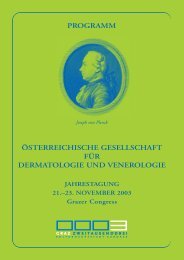PROGRAMM JAHRESTAGUNG 2012 30. Nov. – 2. Dez ... - ÖGDV
PROGRAMM JAHRESTAGUNG 2012 30. Nov. – 2. Dez ... - ÖGDV
PROGRAMM JAHRESTAGUNG 2012 30. Nov. – 2. Dez ... - ÖGDV
Erfolgreiche ePaper selbst erstellen
Machen Sie aus Ihren PDF Publikationen ein blätterbares Flipbook mit unserer einzigartigen Google optimierten e-Paper Software.
Poster Tumore der Haut<br />
P 46<br />
Subcutaneous panniculitis-like T-cell Lymphoma with α/β T-cell phenotype<br />
associated with a hemophagozytic syndrome and maligne ascites<br />
Bettina Kerbler 1<br />
Michael Steurer 2<br />
Matthias Schmuth 1<br />
Elisabeth Muglach 1<br />
Bernhard Zelger 1<br />
Van Anh Nguyen 1<br />
1 Department of Dermatology, Innsbruck Medical University, Innsbruck, Austria<br />
2 Hematology and Oncology, Innsbruck Medical University, Innsbruck, Austria<br />
Introduction: Subcutaneous panniculitis-like T cell lymphoma (SPTL) is a rare skin<br />
T-cell lymphoma characterized by infiltration of the subcutaneous tissue with<br />
pleomorphic T-cells that mimic lobular panniculitis. Patients with SPTL present with<br />
typical nodular lesions or plaques that occur preferentially on the limbs and trunk and<br />
often are misdiagnosed as benign as lupus panniculitis. Distinction should be made<br />
between SPTL with an α/β T-cell phenotype (SPTL-AB) and SPTL with a γ/δ T-cell<br />
phenotype (SPTL-GD). SPTL-ABs are generally confined to the subcutis, have a CD4-,<br />
CD8+, CD56- phenotype, are uncommonly associated with a hemophagocytic<br />
syndrome (HPS, 17 %) and have a favorable prognosis (5-year overall survival 82 %). On<br />
the other hand, SPTL-GDs display epidermal involvement and/or ulceration, a CD4-,<br />
CD8-, CD56+ phenotype and poor prognosis (5-year overall survival 11%). Based on<br />
these observations, the term SPTL is used only for SPTL-ABs, whereas SPTL-GDs are<br />
included into the group of cutaneous γ/δ T-cell lymphoma.<br />
Methods and Results: We report a 34- year- old caucasian woman who noticed<br />
subcutaneous nodules on her left leg and gluteal area. Two months later, she developed<br />
persistently high-grade fevers, night sweats, chills and myalgias. Her abdomen was<br />
distended due to ascites that was confirmed by ultrasound. Laboratory analysis<br />
disclosed panzytopenia (hemoglobulin 100 g/l, WBC count 1,9 G/l, platelets 119 G/l),<br />
elevated transaminases (ASAT 463 U/l, ALAT 197 U/l, γGT 80 U/l) and high levels of<br />
lactatdehydrogenase (LDH) (1642 U/l). Antinuclear antibodies (1:160 speckled pattern)<br />
and dsDNA were initially detected. Positron emission tomography (PET)/computed<br />
tomography (CT) revealed areas of hypermetabolic activity in the subcutaneous<br />
adipose tissue of the left leg and gluteal area as well as in the bones. Furthermore, the<br />
liver and the spleen were markedly enlarged. A deep biopsy from the left leg<br />
demonstrated a dense lobular proliferation of atypical lymphocytes with irregular and<br />
hyperchromatic nuclei that infiltrated the subcutaneous fat with rimming around<br />
adipocytes. No infiltration of the superficial dermis and epidermis was seen. The atypical<br />
lymphocytic infiltrate was stained positive for CD3, CD2, CD7, CD5, CD8, T-cellintracytoplasmic<br />
antigen1 and Granzyme B, but negative for CD 30, CD 56 and EBER.<br />
102









